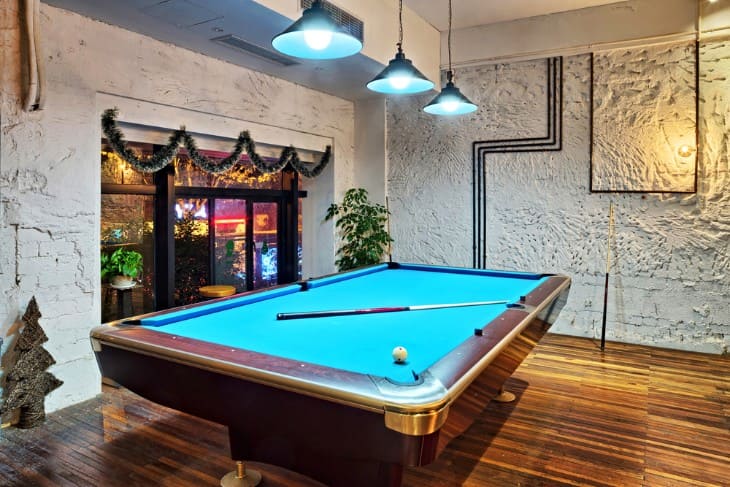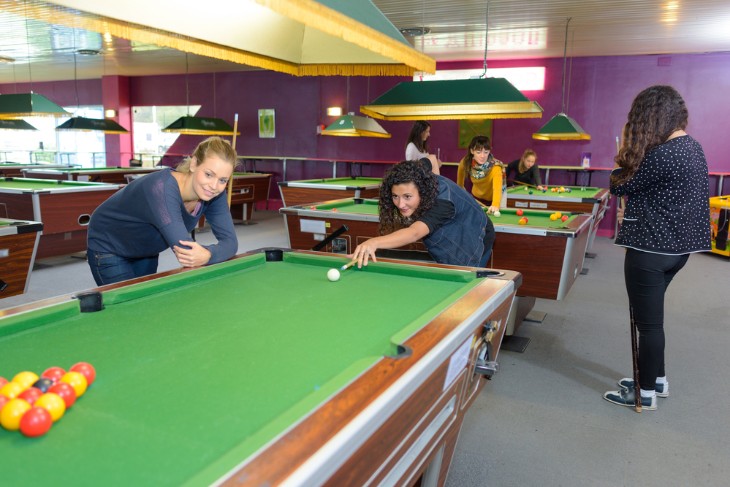By the early 20th century, dedicated snooker halls started to emerge in Britain. These establishments were designed with a clear purpose - to provide avid players with a dedicated space for their beloved game. With the development of specific rules and regulations, the snooker hall as we know it today began to take shape. The historical evolution of snooker halls demonstrates how a simple game created for British soldiers in India evolved into a global phenomenon, with dedicated architectural and design considerations playing a vital role in its development.
Layout and Spatial Planning
The layout and spatial planning of a snooker hall are fundamental aspects that directly impact the player experience and the overall functionality of the establishment. A well-designed layout not only accommodates the requisite number of snooker tables but also ensures that players and spectators can move around comfortably without disruption.
One of the critical considerations in layout design is the arrangement of snooker tables. Tables should be positioned with adequate spacing between them to allow players to move freely while taking their shots. The alignment of the tables is also essential, as it affects the sightlines for both players and spectators. Careful planning ensures that players have sufficient room to cue without obstructions and that spectators have unobstructed views of the games.
Seating arrangements for spectators are another vital aspect of spatial planning. Snooker halls often attract spectators who come to watch skilled players in action. Comfortable seating with clear views of the tables is essential to create a welcoming environment for observers. Additionally, the placement of seating should consider the flow of foot traffic and not impede players' movements. In a well-designed snooker hall, the layout is meticulously crafted to balance the functional needs of the players and the comfort of the audience, contributing to a harmonious and enjoyable experience for all.
Lighting Solutions
Effective lighting solutions are integral to the successful operation of a snooker hall. Proper illumination not only enhances the visibility of the table and balls but also creates an ambiance conducive to focused gameplay. In snooker hall design, natural light is often minimized due to the desire for consistent lighting conditions. Therefore, artificial lighting takes center stage.
The choice of lighting fixtures is crucial. Historically, snooker halls relied on overhead incandescent or fluorescent lighting, but modern halls have transitioned to more energy-efficient and uniform lighting sources. LED lighting, with its versatility and ability to provide consistent brightness, has become the preferred choice. Fixtures are strategically positioned to eliminate shadows and reduce glare, ensuring that players have an unobstructed view of the table's surface. Additionally, lighting systems are often designed with adjustable settings to accommodate different playing conditions, maintaining optimal visibility regardless of the time of day.
Innovations in snooker hall lighting include the incorporation of smart lighting controls. These systems allow for precise adjustments in intensity and color temperature, enabling operators to create custom lighting schemes for various events or tournaments. Overall, the meticulous consideration of lighting solutions in snooker hall architecture plays a pivotal role in providing players with a conducive environment for precision gameplay.

Acoustic Considerations
In the realm of snooker hall architecture and design, acoustic considerations are often overlooked but play a vital role in creating a comfortable and focused atmosphere for players and spectators alike. The nature of snooker, with its quiet concentration and precision shots, demands an environment free from distractions and excessive noise.
One of the primary challenges in snooker hall acoustics is reducing the noise levels generated during gameplay. The impact of balls colliding with each other and the table, as well as the occasional use of chalk by players, can produce unwanted sounds. To mitigate these noises, snooker halls employ sound-absorbing materials strategically placed on walls and ceilings. These materials, often in the form of acoustic panels or baffles, help dampen sound waves and prevent reverberation, creating a more serene playing environment.
Another aspect of acoustic design in snooker halls is soundproofing strategies to isolate the playing area from external noise. This is particularly important for snooker halls located in urban or noisy environments. Double-glazed windows, well-insulated walls, and soundproof doors are common features that help maintain a tranquil interior, ensuring that players can concentrate fully on their game.
Interior Design Aesthetics
While functionality is paramount in snooker hall architecture, interior design aesthetics play a crucial role in creating an inviting and visually appealing atmosphere. The choice of colours, decor elements, and overall interior design can significantly impact the overall ambiance of the hall.
Colour schemes are carefully selected to evoke a sense of sophistication and focus. Neutral tones such as deep blues, dark greens, and burgundies are often chosen for walls and furnishings, creating a calm and elegant backdrop for the vibrant snooker tables and players. These colours not only contribute to a serene environment but also help highlight the vibrant colours of the balls and cloth.
Artwork and decor elements add character to snooker halls. Vintage photographs, memorabilia, and framed snooker cues can adorn the walls, paying homage to the sport's history and adding a touch of nostalgia. Additionally, some halls incorporate subtle branding or logos, reinforcing their identity within the snooker community.
Ventilation and Climate Control
Snooker halls must maintain a comfortable and controlled climate to ensure optimal playing conditions. Proper ventilation and climate control are essential aspects of the architectural and design considerations. Ventilation systems are designed to ensure the continuous flow of fresh air, preventing the buildup of odours and maintaining a pleasant atmosphere.
Snooker halls often host a significant number of players and spectators, and the heat generated by bodies in close proximity can lead to discomfort. Therefore, efficient air circulation and temperature control are crucial. High ceilings and strategically placed ventilation systems help distribute air evenly throughout the hall, preventing stagnant pockets of warm or cold air. Temperature and humidity levels are carefully monitored and controlled to ensure that players can focus on their game without being distracted by extreme conditions. This balance is a testament to the meticulous planning that goes into creating a welcoming and comfortable environment for all.
Accessibility Features
Inclusivity is a vital aspect of modern snooker hall architecture and design. Ensuring that the facility is accessible to individuals with disabilities and diverse needs is both a legal requirement and a moral responsibility. Architects and designers incorporate various features to make snooker halls welcoming and functional for everyone.
One of the primary considerations is the provision of ramps and accessible entryways for wheelchair users and those with mobility challenges. These ramps are often designed to blend seamlessly with the overall aesthetics of the hall, ensuring that accessibility features do not detract from the design's overall coherence. Furthermore, clear signage, including Braille and tactile signs, helps individuals with visual impairments navigate the facility independently.
To accommodate a diverse range of needs, snooker halls may offer adjustable table heights and cue extensions. These adaptations empower players with physical disabilities to participate fully in the sport.
Safety Measures
Safety is paramount in snooker halls, and comprehensive measures are put in place to ensure the well-being of patrons and staff. The risk of fire, though relatively low, is one of the primary concerns addressed through rigorous safety protocols. Snooker halls are equipped with fire extinguishers, smoke detectors, and sprinkler systems to provide immediate response in case of a fire emergency. Clear evacuation routes and exit signs are prominently displayed, ensuring that patrons can quickly and safely exit the premises if needed.
Emergency exits are strategically located to facilitate swift evacuations. These exits are designed to open easily and are clearly marked, allowing occupants to reach safety without confusion. Regular fire drills and staff training further enhance preparedness, ensuring that everyone knows how to respond in case of an emergency.
In addition to fire safety, snooker halls prioritize general safety. Measures are taken to prevent slip and fall accidents, including the use of non-slip flooring materials and regular maintenance to address any hazards promptly. First-aid kits are readily available, and staff members are trained in basic first aid to provide assistance if necessary.

Sustainable Practices
The awareness of environmental responsibility has permeated various industries, including snooker hall architecture and design. Sustainable practices are increasingly integrated into the construction and operation of these establishments. Energy efficiency is a primary focus, with snooker halls adopting LED lighting, energy-efficient heating and cooling systems, and programmable thermostats to reduce energy consumption.
Sustainable materials are also a consideration. Many snooker halls opt for eco-friendly construction materials, including those with recycled content or sustainably sourced materials. The use of low-VOC (Volatile Organic Compounds) paints and finishes contributes to improved indoor air quality. Waste management practices, including recycling and responsible disposal of materials, are implemented to reduce the environmental impact of construction and ongoing operations.
Furthermore, snooker halls often engage in community initiatives and charity events, showcasing a commitment to giving back to the local area. Sustainability, both in terms of environmental consciousness and community involvement, is a growing aspect of snooker hall architecture and design, aligning these establishments with broader societal values and expectations.
Technological Advancements
In the digital age, snooker halls have not remained untouched by technological advancements. The integration of cutting-edge technologies enhances the player experience and the overall efficiency of these establishments. One notable advancement is the adoption of automated scorekeeping systems. These systems not only reduce the risk of human error in scorekeeping but also provide real-time updates to players and spectators, enhancing the excitement of the game.
Surveillance and security technologies have also become integral to snooker hall operations. High-quality CCTV systems are strategically positioned to monitor all areas of the establishment, ensuring the safety of patrons and the security of the facility. In addition to traditional security measures, some snooker halls have implemented biometric access control systems to restrict entry to authorized personnel only.
The integration of technology in snooker hall architecture and design extends to the provision of Wi-Fi access for patrons, allowing players to stay connected while enjoying their games.
Conclusion
In conclusion, the architecture and design of snooker halls encompass a wide array of considerations, all aimed at creating an optimal environment for players and spectators. From the historical evolution of the game to the incorporation of cutting-edge technologies, snooker hall design is a blend of tradition and innovation. The layout, lighting, materials, acoustics, and interior aesthetics all come together to create a space that not only facilitates exceptional gameplay but also offers an inviting and enjoyable atmosphere for all who visit.
For more information:











